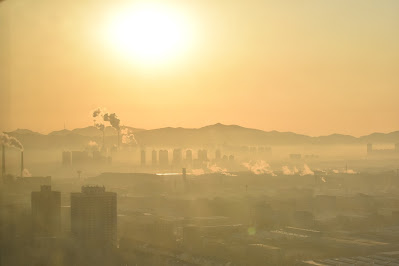The science of smog...
On July 26, 1943, Los Angeles
was blanketed by a thick gas that stung people's eyes and blocked out the Sun.
Panicked residents believed, their city had been attacked using chemical warfare.
But the cloud wasn't an act of war. It was smog. A portmanteau of smoke and fog,
The word "SMOG" was coined at the beginning of the 20th century to describe the thick
gray haze that covered cities such as London, Glasgow, and Edinburgh. This industrial
smog was known to form when smoke from coal-burning, home stoves and factories
combined with moisture in the air. But the smog behind the LA panic was different. It had
a chemical odor. Since the city didn't burn much coal, its cause would remain a mystery
until a chemist named Arie Haagen-Smit identified two culprits:
Volatile Organic Compounds or VOCs, and Nitrogen Oxides. VOCs are compounds
that easily become vapors and may contain elements, such as carbon, oxygen,
hydrogen, chlorine, and sulfur. Some are naturally produced by plants and animals,
but others come from man made sources, like solvents, paints, glues, and petroleum.
Meanwhile, the incomplete combustion of gas in motor vehicles releases Nitrogen Oxide.
That's what gives smog its yellowish color. VOCs and Nitrogen Oxide react with sunlight
to produce secondary pollutants, called PANs and tropospheric, or ground-level, Ozone.
PANs and Ozone cause eye irritation and damage lung tissue. Both are key ingredients
in photochemical smog, which is what had been plaguing LA. 
pixabay
So, why does smog affect some cities but not others?
Industrial and photochemical smog combine man made pollution with local weather and
geography. London's high humidity made it a prime location for industrial smog.
Photochemical smog is strongest in urban areas with calm winds and dry, warm weather.
The ultraviolet radiation from sunlight provides the energy to breakdown molecules that
contribute to smog formation. Cities surrounded by mountains or lying in a basin,
are also especially vulnerable to smog, since there's nowhere for it to dissipate.
That's also partially due to a phenomenon known as temperature inversion, where warm
air continuously rising upward, a pollution-filled layer of air remains trapped near the
Earth's surface by a slightly warmer layer above. 
pixabay
Smog isn't an aesthetic eyesore. Smog irritate the eyes, nose, and throat,
exacerbate conditions like asthma and emphysema, and increase the risk of respiratory
infections like bronchitis. Smog can be harmful to young children and older people and
exposure in pregnant women has been linked to low birth weight and birth defects.
Secondary pollutants found in photochemical smog can damage and weaken crops and
decrease yield, making them more susceptible to insects. 
pixabay
Yet for decades, smog was seen as the inevitable price of
civilization. Londoners had become accustomed to the notorious pea soup fog swirling
over their streets until 1952, when the Smog of London shut down all transportation
and caused more than 4,000 respiratory deaths. As a result, the Clean Air Act of 1956,
banned burning coal in certain areas of the city, leading to a massive reduction in smog.
Similarly, regulations on vehicle emissions and gas content reduced volatile compounds
in the air and smog levels along with them. Smog remains a major problem around the
world. Countries that depend on coal for energy, experience high levels of
smog. Photochemical smog and airborne particles from vehicle emissions
affect many rapidly developing cities, from Mexico City and Santiago to New
Delhi and Tehran. Governments have tried many methods to tackle it,
such as banning cars from driving for days at a time. As more than half
of the world's population crowds into cities, considering a shift to mass transit and
away from fossil fuels may allow us to breathe easier.
Posting Komentar untuk "The science of smog..."